Rabbit Terms
Rabbit Terms: This is a glossary of the most common rabbit-related terms used by rabbit owners and breeders in reference to most aspects of rabbit care.
The intent of this page is to give you the terminology used in the domestic rabbit world, whether you own a single pet, or you breed rabbits for meat, show, fiber, or fur. We'll list and define the most common words, and if you need more info, follow the link at the bottom of this page to a comprehensive PDF of rabbit terms provided by the Ag Department at North Dakota State University.
General Rabbit Terms
Buck: Male rabbit
Sire: The male parent/grandparent (etc.) of another rabbit
Doe: Female rabbit
Dam: The female parent/grandparent (etc.) of its offspring.
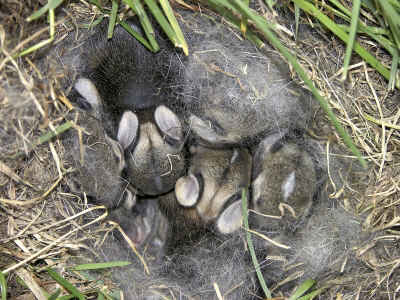 Cottontail bunnies nesting in cut grass
Cottontail bunnies nesting in cut grassBrood, especially "brood doe": A doe of excellent quality which is used for breeding purposes. This is frequently applicable to rabbit does of the smaller dwarfed breeds. In these breeds, a well-conformed "false dwarf" doe which has exceeded the weight limit for the breed might be kept for producing offspring that the breeder knows will excel on the show table. See Dwarf Rabbits.
Cottontail Rabbits: Cottontails are the new-world wild rabbits of the United States, Canada, and Mexico. They belong to the genus Silvilagus, and are split into three species: S. audubonii, S. palustris, and S. floridanus. (Pictured: a nest of young cottontails in someone's lawn.)
Domestic Rabbits: Every domestic rabbit around the world is derived from the wild rabbits of Europe and England. They pertain to the genus and species Oryctolagus cuniculus. Both cottontails and domestic rabbits are lagomorphs, differing from rodents only in their teeth structure. Rodents have 4 opposing incisors in the front of their mouths, while lagomorphs have 6 teeth: four incisors and two peg teeth directly behind the upper incisors.
Herd: The collection of rabbits in a rabbitry. "It's a herd, not a hoard."
Kitten, kit: Rabbit babies, rabbit youngsters. Youngsters are also sometimes called "doelings" (female) or "bucklings" (male)
Foster: To give unweaned kits to a different milking doe so she can finish raising them to weaning age.
Palpation: The technique of feeling a doe's abdomen in an attempt to determine whether a doe is pregnant or not. This involves placing 4 fingers on one side of the doe's abdomen and the thumb on the other side, and sliding your hand back and forth to "look for" the small lumps indicative of babies in the uterus.
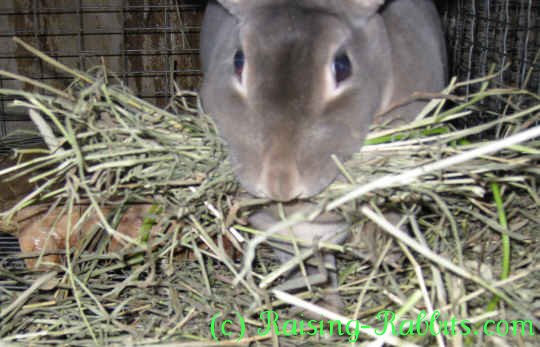 A "haystache" is a sure sign of a pregnant rabbit.
A "haystache" is a sure sign of a pregnant rabbit.Gestation: The length of time taken from breeding/conception to kindling. This time frame is most frequently 31 days.
"Haystache": The ginormous mouthful of hay a pregnant doe gathers in her mouth for nest building purposes. It is so called because it resembles a mustache made of hay.
Kindle: Give birth to.
Litter: All the kits a doe kindles from the same pregnancy.
Nest Box: The box in which a doe kindles her kits. It might be made of wood, plywood, metal, or wire mesh, and comes in several sizes so you can match the size of the box to the size of your doe. The nest box is prepared by filling it with 3 layers: shavings on the bottom, a middle layer of straw, and then a top layer of grass hay.
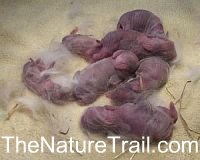 2 dead peanuts in this newborn litter of seven.
2 dead peanuts in this newborn litter of seven.Peanut: Refers to kits of dwarf breeds that carry two copies of the dwarfing gene. This combination is always fatal. If the kit is not already born dead, it will most likely die within the first two weeks. See Dwarf Rabbits.
Weaning: The process of recognizing that a kit is fully capable of eating and drinking on its own, and then removing the kit from the doe. Ideally, the process of weaning takes place in increments over a period of approximately a week. See Weaning Rabbits, and Weaning Worries.
Rabbit Raising Problem Solver and the e-book, Rabbit Reproduction, both provide a comprehensive scope of information and guidance for breeding and raising rabbits.
Rabbit Terms about Housing
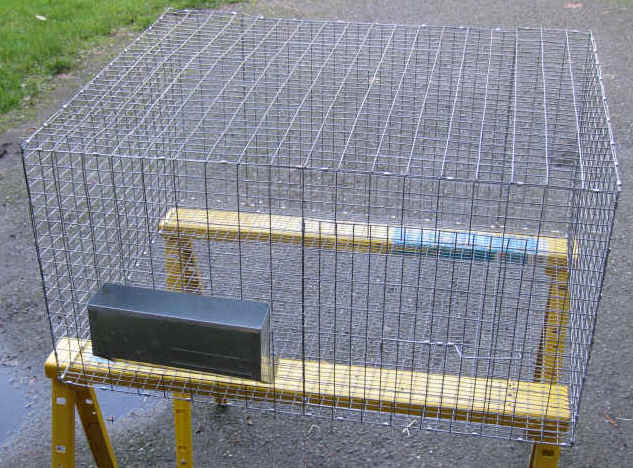 Homemade rabbit cage suitable for a large rabbit.
Homemade rabbit cage suitable for a large rabbit.Cage: Housing or home for a rabbit. See photo. Even house rabbits do best with a cage where it can be confined for its own protection if needed. Build your own cages with these free plans! See Rabbit Cage Plans.
Cage Floor: An all-wire cage floor is healthiest for rabbits, as it permits droppings to fall through to the ground and away from the rabbit. This breaks the life cycle for many parasites. It is important to ensure that the rabbit's feet stay well-furred. See Resting Board, below.
Colony: A common living space housing a number of rabbits intermingling on the ground. Also known as a warren. In the wild, warrens are made up of a network of underground tunnels connecting sleeping quarters, food storage rooms, and nesting burrows.
Hole: A single rabbit housing unit.
Hutch: A rabbit cage and covering, on legs. Traditionally built of wood and wire, frequently with two holes - two cages under the single hutch roof. A new system was developed by Raising-Rabbits.com consisting of a PVC hutch frame on which can hang from 2 to 6 wire cages. This system is not a hutch, technically, because it has no roof and must be placed in a shed, barn or other covered structure, but it is very healthy for rabbits, and easy to use for the humans tending their rabbits. See more about rabbit hutch frames and hanging cages here.
Resting Board: A mat or other flat surface placed inside the cage and big enough for the rabbit to rest on. This helps protect rabbit feet from developing sore hocks. See Sore Hocks, below.
Wire: Welded wire mesh, typically 1"x2" for cage sides and roof (12 gauge or 14 gauge), and 1"x1/2" for cage floors. Floor wire is typically 16 gauge, but 14 gauge is better. AVOID purchasing or using cheap, small-gauge wire such as chicken wire or wire mash lighter than 16 gauge. (Lighter gauge wire is more damaging to the hocks, and much easier for predators to destroy.)
Rabbit Terms about Feeding
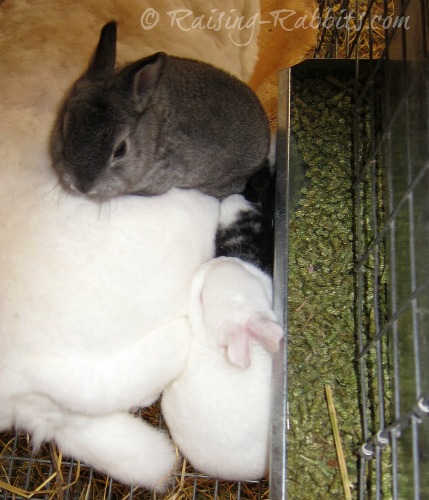 Metal J-Feeder filled with rabbit pellets.
Metal J-Feeder filled with rabbit pellets.Feed: Everything a rabbit eats. Recommended are a good quality complete rabbit pellet supplemented with extra fiber in the form of hay, and sometimes adding an extra source of protein and fats such as whole oats or black oil sunflower seeds.
Fiber (1): Fibrous roughage. Sufficient fiber is essential for a rabbit's healthy digestive function. Low fiber results in digestive upsets, diarrhea, and possibly death.
Hay: Grasses. Common hays are alfalfa (lucerne), timothy, and orchard hay.
Pellets: Commercial rabbit feed. Called pellets because it comes in pelleted form. See photo.
Rabbit Terms about Rabbit Farming
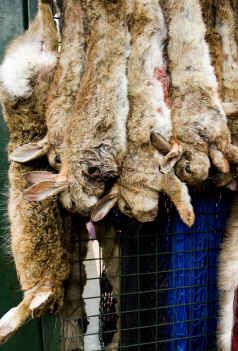 Rabbits for dinner hanging in the marketplace.
Rabbits for dinner hanging in the marketplace.Commercial Rabbit Breeds: Breeds used for meat rabbit production. These are bred for rapid growth, meatiness, and a medium (not too heavy) bone structure. By far and away the most common meat rabbit breeds are New Zealand White, Californian, and Tamuk rabbits. A few other rabbit breeds are also known as having commercial type. See Meat Rabbits. See also our Intro to Raising Rabbits Commercially.
Fiber (2): Angora wool is referred to as fiber by those who raise wool bearing rabbits in order to harvest and spin the wool into skeins of fiber.
Fryer: A young rabbit of approximately 8-10 weeks old that is intended for the meat market. Fryer meat is tender and easy to eat.
Processing: Turning a living rabbit into a marketable meat product, such as raw meat for pets, or even rabbit meat for the homesteader's own table. Find more on processing rabbits here.
Roaster: Rabbits older than fryers, but under 5-6 months or so of age. They are too tough to fry, but not too tough to roast in the oven.
Stewer: Rabbits that are 6-8 months old to several years old, that are so tough they must be crock-potted or otherwise cooked a very long time in order to be eaten.
Tamuk Rabbits: A composite rabbit breed developed by Dr. Lukefahr at Texas A&M University at Kingsville, hence the breed name, "TAMUK." This is really a "strain" of New Zealand White developed for enhanced meat production and also color variety.
(See Animal Rights below if you have questions about the morality of butchering and eating animal nutrition.)
Rabbit Terms Pertaining to Health
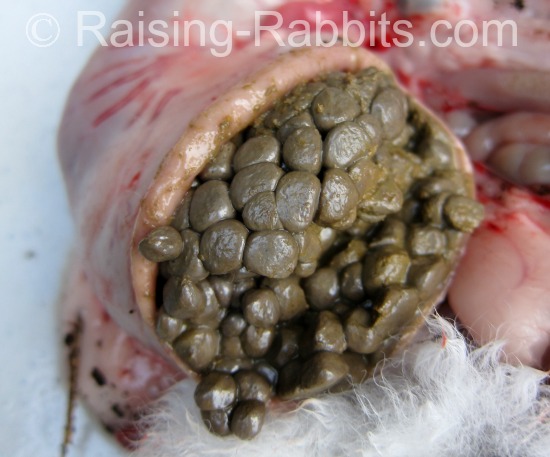 Rabbit stomach opened up to reveal it is full of cecotropes.
Rabbit stomach opened up to reveal it is full of cecotropes.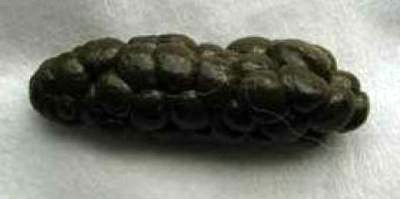 A single rabbit cecotrope.
A single rabbit cecotrope.Cecotropes: Also called night droppings. The rabbit's digestion operates on two cycles. One cycle processes the food and then aggregates the solids and fiber, excreting these as the familiar round rabbit droppings. See Droppings, below. The second cycle excretes the nutritious, bacteria-laden, soft contents of the hind gut, which the rabbit eats again directly from its anus.
Of the total protein intake gained by eating cecotropes, up to 68% is derived directly from digesting the bacteria excreted in the cecotropes. Other vitamins, such as B12, are also sourced solely from these bacteria. The ability to thus reprocess its food a second time greatly enhances the rabbit's nutritional intake and health. This is an herbivore capability and nutritional source which humans (omnivores) do not share. See more about cecotropes and rabbit digestion here.
Diarrhea/Enterotoxemia: Most rabbit diarrhea is caused by an upset in the bacterial flora of the intestinal tract and hind gut. High carbohydrate intake from sweet treats can cause a bloom of pathogenic (disease-causing) bacteria. When this happens, toxins can both flood the blood stream and inflame the intestinal tract. This is what causes the diarrhea. The toxins can kill the rabbit, sometimes within 12-24 hours, or even before the onset of diarrhea. See more about rabbit diarrhea here.
Droppings, Marbles, "Black Gold": Rabbit feces. These are shaped like little round balls, hence the term marbles. Also known as "black gold," since they are one of the best natural fertilizers for the garden. Rabbit droppings as fertilizer are called a "cold" fertilizer, since they can be applied immediately to the garden without risk of burning or harming plants.
Hind Gut: Also known as the cecum. The cecum is the largest structure in the rabbit's gastrointestinal tract. It holds a large population of healthy gut bacteria that contribute to rabbit digestion and health, and without which the rabbit would die. The contents of the hind gut are excreted as cecotropes. See Cecotropes, above.
Pasteurellosis/Snuffles: Respiratory illness caused by the germ Pasteurella multocida. In rabbits, this is a particularly insidious germ, as it has the ability to elude the immune system, among other ways by hiding in the sinuses. For this reason, the prognosis for a cure is exceedingly dismal, although not unheard-of. The symptoms include nasal drainage, clear, white, or yellow snot, repetitive sneezing and snuffling, and matted fur on the forearms from continually wiping at its nose. See more on snuffles here.
Rabbit Teeth: All of a rabbit's teeth, incisors, peg teeth, and molars alike, continue growing throughout its life. This is not a problem if the alignment is correct and the rabbit can gnaw on and chew wood and roughage on a regular basis. Should the alignment go askew, either from pulling teeth on cage wire, or genetic malocclusion, or bone softening, the incisors will begin to elongate and to curl inside and outside of the rabbit's mouth.
This condition is known as malocclusion, also called buck teeth, or wolf teeth. The eventual result is an inability to chew. The rabbit will starve to death if the teeth are not trimmed. While the problem is obvious in incisors, note that the molars inside the mouth can also elongate and impede eating. See Rabbit Teeth.
Sore Hocks: Sores, usually on the hocks of the hind feet. This is more common in thin-furred or short-furred animals. The cause is excessive pressure directly on the hocks. See Rabbit Feet for causes and solutions.
Rabbit Terms and Animal Rights
Animal Welfare vs Animal Rights: Animal welfare is the healthy interest in providing the best life and the best care possible for one's animals.
On the other hand, animal rights is a philosophical belief that people should be vegans, having nothing to do with any uses of animals or animal products at all. Because of a lack of a moral basis for this belief system, a low percentage of individuals have actually bought into the vegan mindset.
Therefore, its more radical proponents have resorted to terrorist tactics and violence such as trespassing and opening cages, stealing animals, shooting and killing animals in their fields, burning barns down, and bringing false charges of animal abuse to farmers, breeders, and pet owners.
Currently, the animal rights movement has been redefining terms and using the legal system to codify protections for the animal rights system, and then falsely accusing animal breeders with the stated intent of eliminating all breeders one at a time. They have also been attacking rodeos, zoos, and circuses because of their belief that animal ownership is wrong.
See the articles linked through our Animal Rights page.
PDF of Rabbit Terms
Click here to access a comprehensive PDF of Rabbit Terms provided by the North Dakota State University Agriculture Department. Besides these general rabbit terms, the PDF includes rabbit terminology about rabbit shows, rabbit terms used in the standards of perfection in the USA, rabbit terms pertaining to rabbit genetics, and some additional colloquial rabbit terms, such as "binky" (the motion of leaping vertically, thought to be due to happiness).
Rabbit Raising Problem Solver is an excellent resource for all rabbit breeders and rabbit lovers interested in a better understanding of all aspects of taking care of rabbits.
Double-Value Guarantee
Our policy is to always OVER-deliver
on value,
which is why your purchase is fully covered by our
Double-Value
Guarantee.
Go ahead - take any of our e-books for a test drive. Peruse our detailed informational and educational e-books. Examine our plans for building rabbit cages, runs, or metal or PVC hutch frames. Check out the Rabbit Husbandry info e-books.
If you aren't completely satisfied that your e-book purchase is worth at least double, triple or even quadruple the price you paid, just drop us a note within 45 days, and we'll refund you the entire cost. That's our Double-Value Guarantee.
Note: When you purchase your
e-books, they will be in PDF format, so you can download them to any device that
supports PDF format. We advise making a back-up copy to a drive or cloud
account. If the books are lost, you can also purchase another copy from Raising-Rabbits.










New! Comments
Have your say about what you just read! Leave me a comment in the box below.